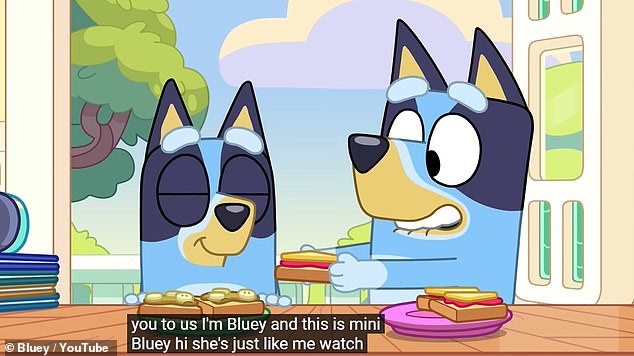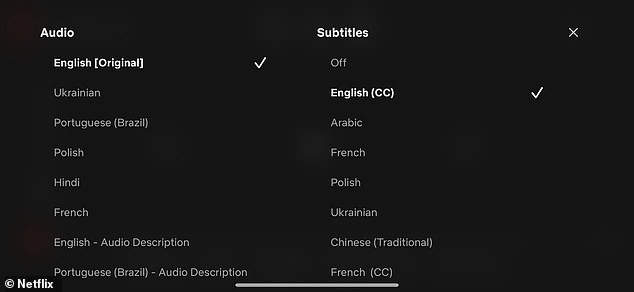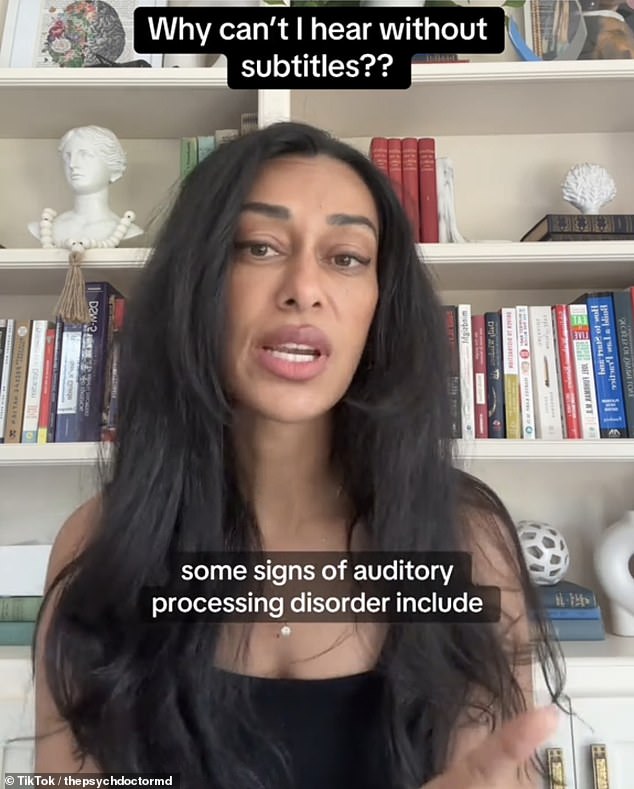So THAT’S the reason! Common but little-known condition could explain why you need subtitles to watch TV – despite having good hearing
If you have trouble following your favorite TV shows without subtitles, it doesn’t have to be because there’s something wrong with your hearing.
Experts say a common but little-known condition could be the cause.
According to psychiatrist and ADHD specialist Dr. Sasha Hamdani, the inability to follow dialogues could be a sign of auditory processing disorder (APD).
APD affects approximately five percent of the population and can make it extremely difficult to understand auditory information.
Speaking in a video posted to her TikTokDr. Hamdani says, “APD essentially means that even though you can hear fine, your brain has trouble translating speech into something you can understand.”
Psychiatrist and ADHD specialist Dr. Sasha Hamdan explains that you may feel like you need captions because of a common condition
With the rise of video-on-demand services like Netflix and Amazon, the use of subtitles is becoming more common, especially among younger viewers.
A recent YouGov survey found that only 28 percent of people say they prefer watching TV and movies with subtitles. Among 18-24 year olds, however, that figure is 61 percent.
Some people prefer to watch with subtitles, while others find that they cannot understand what they are watching without subtitles.
Dr. Hamdani says, “You might be distracted by background noise, sound effects, or the soundtrack. Maybe the volume changes and someone whispers and you can’t hear them.”
If this sounds familiar, you may have APD.

If you always need to have subtitles on, it could be a sign that you have an auditory processing disorder (APD).
In her TikTok video, Dr. Hamdani explains, “Some signs of auditory processing disorder include: having difficulty understanding what people are saying, especially in places with a lot of background noise.”
Dr. Hamdani also points out that symptoms may include difficulty following verbal instructions or not always being able to respond immediately when spoken to.
According to the NHS, APD is a disorder in which you have difficulty understanding sounds, including spoken words.
The condition usually develops in childhood and can cause problems at school, but some people can develop APD later in life.
Because people with APD may have difficulty following spoken conversations in noisy places, it can be particularly difficult to follow dialogue in television shows or movies, where music or sound effects are often playing in the background.

People with APD have difficulty interpreting spoken information when there is background noise. This means that subtitles can help people with the condition follow the dialogue in TV shows and movies.
This means that subtitles can be extremely helpful for people dealing with this condition.
In a blog post, Empire Caption Solutionsa captioning service provider, writes: ‘People with auditory processing issues may have difficulty distinguishing similar sounds and understanding speech over background noise. In addition, it may take longer for them to realize what they have heard.’
“Seeing the captions and hearing the spoken words or sounds at the same time can help someone with APD process the information they have heard more quickly and keep up with the pace of the audio as it plays.”
As Dr. Hamdani points out, you can still suffer from this condition even if you have otherwise perfect hearing.
She says, “That’s why subtitles help. You’re dependent on reading because you have trouble interpreting what you’re hearing.”
Still, watching with subtitles all the time isn’t necessarily a bad thing.
Scientists even say that children should be encouraged to watch television with subtitles to improve their reading skills.
Researchers found that children ages four to seven are twice as likely to become proficient readers if they watch television with subtitles on.
This is because anyone who sees subtitles on the screen has to watch them and follow the content.
A 1997 study by researchers at the University of Leuven found that both children and adults exhibit ‘automatic reading behavior’.
That effect also helps people focus on what’s happening, which can help people Focus on information like dialogue and plot.
APD is often confused with ADHD in children because the two disorders have several overlapping symptoms. However, there are some important differences.
A 2018 study found that children with APD have problems related exclusively to sound, while ADHD causes more general disruptions.
For example, people with APD find it difficult to learn songs or locate the source of a sound.

Dr. Hamdani says that people with ADHD also suffer from APD. The two conditions are different, but in practice it can be very difficult to distinguish between them.
People with ADHD may have difficulty with auditory tasks, as well as with following written instructions.
However, because auditory processing problems can affect attention and executive functions, it can be difficult to distinguish between the two conditions.
ADHD also makes it harder for people to concentrate on auditory information, which can make it difficult to distinguish between sounds in a distracting environment.
To make matters even more confusing, many people have both ADHD and APD.
Dr. Hamdani says, “I’m an ADHD specialist and I see this all the time.
“If you’re thinking this sounds a lot like ADHD, you’re not wrong. APD is more common in neurodivergent people, so you may feel like you need subtitles because without them, it’s too hard to follow a show or movie.”
